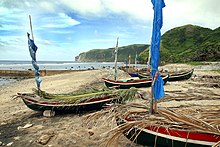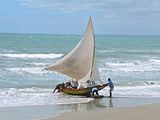|
Tataya
 Tataya are traditional small fishing boats, with or without outriggers of the Ivatan people in the Philippines. They are generally round-hulled and powered by rowers or sails made from woven pandanus leaves. They have several variants based on size and island of origin. The term tataya can also be used for all traditional boats in the Batanes Islands in general, similar to the term bangka in the rest of the Philippines.[1][2] TypesSizeThe following are the traditional types of tataya based on size:[1][2]
RegionBatanThe tataya of Batan Island are generally divided into four types: the Basco and Mahato tataya, the Ivana tataya, and the Uyugan tataya.[1] Basco and Mahatao tataya share the same fishing grounds and thus are identical in construction. The boats are rounded with thin ribs (lagkaw) and four strakes (tavas) at the sides, including the topmost strake, the pamekpekan. The prow is raised higher than the rest of the boat.[1] Ivana tataya are built for maneuverability. Sitting slightly lower than Uyugan tataya. The ribs are squared and thin, while the keel (managad) and the lowest strakes (manpid) are carved from a single log. It does not have a plank-sheer (sintas) unlike other tataya.[1] Uyugan tataya are heavier than the other tataya. They are shorter than the Basco and Mahatao tataya. They sit higher than Sabtang and Ivana tataya on the water. The strakes are thick and they have an open side.[1] ItbayatTataya from the island of Itbayat are built for stability due to the rougher waters around the island. They have a wide body and a flat bottom. They have five strakes. The prow and the stern are also characteristically rounded, unlike those of other tataya which are pointed. It is the only type of tataya with outriggers (patid), which is generally reserved for the larger types of Ivatan boats. Other tataya do not have outriggers.[1] SabtangTataya from the island of Sabtang have very shallow and pointed sterns. The thole pins are fastened to a third-tier plank (pinatapid) attached to the topmost strake (pamekpekan).[1] See alsoReferences |





